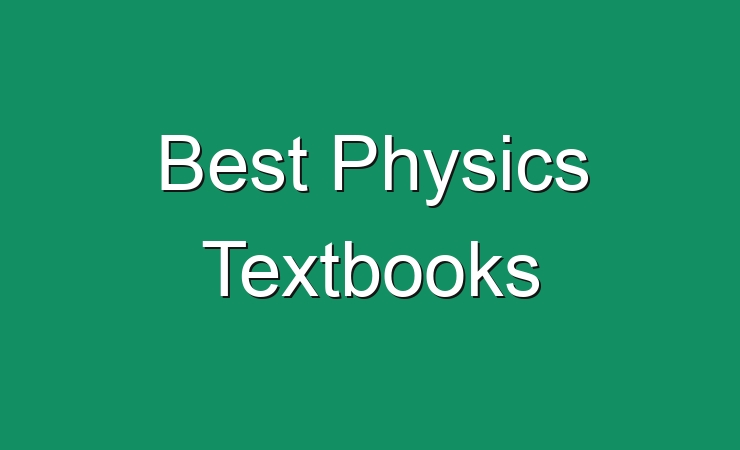In the hallowed halls of academic prestige, few disciplines command as much reverence as physics. The study of the very fabric of the universe invites students to embark on a cerebral journey fraught with intellectual challenges and exhilarating discoveries. Within this context, physics textbooks serve as both the compass and the map through an intricate landscape of concepts ranging from the infinitesimally small to the vast cosmos. At institutions like Harvard and MIT, these tomes are not merely instructional resources; they are gateways to understanding the universe’s profound mysteries.
The textbooks used at these esteemed institutions are a carefully curated collection designed to ignite curiosity and foster deep comprehension. They delve into the fundamental principles of physics while simultaneously challenging students to grapple with the complexities of advanced theories. The following exploration elucidates some of the most prominent textbooks employed in these academic bastions, highlighting their distinctive attributes and pedagogical significance.
1. “University Physics” by Young and Freedman
“University Physics” is celebrated for its clear exposition and thorough coverage of classical mechanics, electromagnetism, and thermodynamics. Known for its rigorous approach, this textbook weaves together theoretical underpinnings with practical problem-solving techniques. The authors artfully employ a dialogic style that invites students to ponder the intricacies of natural phenomena. Each chapter culminates in engaging problems that range in complexity, fostering not only retention but also the application of concepts ingrained within its pages.
The unique appeal of “University Physics” lies in its integration of conceptual tools that resonate deeply with budding physicists. Visual representations, such as annotated diagrams and graphs, complement the written word, serving as a bridge between abstract ideas and tangible understanding. This book stands as a testament to the symbiotic relationship between theory and reality—a principle that permeates the discipline itself.
2. “Fundamentals of Physics” by Halliday, Resnick, and Walker
This venerable textbook has become a staple in introductory physics courses at elite institutions. Its reputation is bolstered by meticulously crafted narratives that elucidate fundamental concepts with remarkable clarity. “Fundamentals of Physics” exemplifies the notion that physics is not merely a collection of equations; rather, it is a lens through which reality can be interpreted and understood.
Each chapter unfolds like a masterfully composed symphony, where theoretical constructs harmonize with real-world applications. The inclusion of historical context enhances the learning experience, allowing students to appreciate the evolution of scientific thought. Halliday, Resnick, and Walker emphasize critical thinking and problem-solving, ensuring that students are not passive recipients of information but active participants in the scientific process.
3. “Classical Mechanics” by Herbert Goldstein
Goldstein’s “Classical Mechanics” is a monumental text renowned for its depth and rigor, specifically tailored for advanced undergraduate and graduate students. Its thorough treatment of dynamics, oscillatory motion, and Hamiltonian mechanics illustrates the elegance of classical physics. The book transcends mere calculation by ushering students into the realm of abstraction—where the mathematical representation of physical systems begins to take precedence.
The discourse within Goldstein’s work demands perseverance and ingenuity, encouraging students to engage fully with the material. Here, physics metamorphoses from formulas on a page to a language through which the universe speaks. The centerpiece of this textbook is the theory of symmetries and conservation laws, fundamental principles that address the underlying unity of the physical world.
4. “Introduction to Electrodynamics” by David J. Griffiths
In the study of electromagnetism, Griffiths’ “Introduction to Electrodynamics” has achieved a near-iconic status. This textbook is revered for its clarity and approachability, traits that make intricate concepts accessible to students. Griffiths crafts his narrative with an engaging tone and a didactic style that encourages inquiry. The interplay between electricity and magnetism is depicted not merely as a static phenomenon but as a dynamic interplay that shapes our universe.
One of the text’s unique features is its balance between mathematical rigor and conceptual insights. It artfully guides students through complex problems while nurturing a visceral understanding of electromagnetic theory. It is within these pages that students often begin to grasp a profound truth: the elegance of physical laws can be both beautifully simple and intricately complex, reflecting the duality inherent in the nature of reality.
5. “Modern Physics” by Serway and Jewett
As one ventures into the realm of modern physics, Serway and Jewett’s textbook becomes an invaluable resource. Covering pivotal topics such as quantum mechanics and relativity, this work bridges classical physics and the revolutionary ideas that have reshaped our understanding of the universe. The authors use a narrative approach that aligns historical developments with scientific concepts, thereby situating modern physics within a larger dialogue of human inquiry.
The textbook’s significance lies in its ability to demystify abstract ideas while fostering a sense of wonder about the microscopic and macroscopic realms. Students are encouraged to not only embrace the complexities of modern physics but also to appreciate the relentless quest for knowledge that drives the field forward. This dynamic interplay of discovery and inquiry makes “Modern Physics” a quintessential element of the curriculum at institutions like Harvard and MIT.
In conclusion, the textbooks utilized in Harvard and MIT serve as pillars that support the edifice of physics education. These texts embody a confluence of rigorous academic tradition and innovative pedagogical strategies. They invite students to not only comprehend the laws governing our universe but to engage in a lifelong dialogue with the mysteries that lie beyond. In the great quest of understanding, each textbook represents a vital key—unlocking the door to not just knowledge, but to enlightenment on the nature of existence itself.












